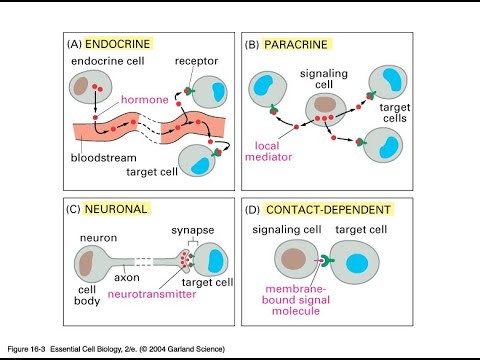
Types of Signaling; Paracrine, Autocrine, Endocrine, and Neuronal Signaling
#cellsignaling #biotechnology #cell #signaling
This video (https://youtu.be/BhrVnnAuVRk) will describe the different types of signaling; Paracrine/Short Range Signaling, Autocrine, Endocrine, and Neuronal Signaling. To have a better understanding of types of receptors, you need to have a better understanding of ligands and receptors and the following videos might be helpful
Ligands and Receptors Part 1
https://youtu.be/ZMhwjX5iy5U
Ligands and Receptors Part 2
https://youtu.be/LDNosXFgwks
In the complex network of cells that make up the human body, communication is crucial for maintaining homeostasis and coordinating various physiological processes. One of the fundamental mechanisms through which cells communicate is through signaling molecules. This transcript explores four key types of cell signaling: paracrine, autocrine, endocrine, and neuronal signaling. Each of these signaling pathways plays a vital role in intercellular communication and has unique characteristics and modes of action.
Paracrine Signaling:
Paracrine signaling occurs when cells release signaling molecules, called paracrine factors, into the extracellular fluid to influence nearby cells. The paracrine factors act locally and do not enter the bloodstream. Examples of paracrine factors include growth factors, cytokines, and neurotransmitters. The signaling molecules diffuse through the interstitial fluid and bind to specific receptors on neighboring cells, triggering a response. Paracrine signaling is essential in processes such as embryonic development, immune responses, and cell growth regulation.
Autocrine Signaling:
Autocrine signaling is a form of cell signaling in which a cell secretes signaling molecules that bind to receptors on its own surface, leading to a response within the same cell. In other words, the signaling molecule acts on the cell that produced it. This self-stimulation allows cells to regulate their own behavior and coordinate their activities. Autocrine signaling is often involved in processes like cell proliferation, differentiation, and immune responses.
Endocrine Signaling:
Endocrine signaling involves the release of signaling molecules called hormones into the bloodstream by specialized endocrine cells. These hormones are then transported throughout the body, binding to specific receptors on target cells in distant tissues or organs. Unlike paracrine or autocrine signaling, endocrine signaling allows for widespread and systemic communication within the body. Examples of endocrine glands include the thyroid gland, pancreas, and adrenal glands. Hormones regulate a wide range of physiological processes, including metabolism, growth, reproduction, and stress response.
Neuronal Signaling:
Neuronal signaling, also known as synaptic signaling, is a specialized form of cell signaling that occurs in the nervous system. Neurons, the fundamental units of the nervous system, transmit signals electrically and chemically across synapses. Electrical signals, known as action potentials, travel along the length of a neuron, while chemical signals, in the form of neurotransmitters, are released at the synapse to transmit the signal to the next neuron or target cell. Neuronal signaling is responsible for controlling body movements, sensory perception, cognition, and numerous other physiological functions.
Conclusion:
Paracrine, autocrine, endocrine, and neuronal signaling are crucial mechanisms for intercellular communication in the human body. These signaling pathways allow cells to coordinate their activities, regulate growth and development, respond to changes in the environment, and maintain homeostasis. Paracrine signaling acts locally, autocrine signaling self-stimulates within the same cell, endocrine signaling involves widespread communication through the bloodstream, and neuronal signaling enables rapid transmission of signals in the nervous system. Understanding these different modes of signaling enhances our comprehension of physiological processes and provides insights into the mechanisms underlying health and disease.